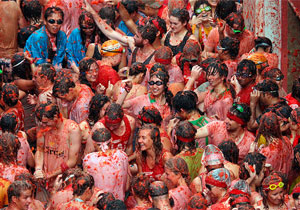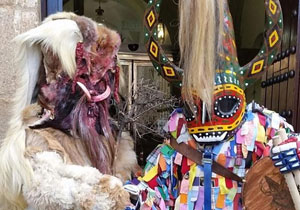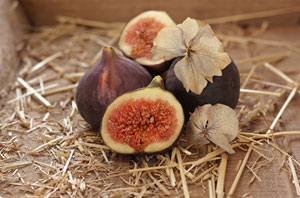La Tomatina

The last Wednesday of August, in the patron festivities of Buñol, the famous Tomatina is celebrated. It is a prestigious festival that is 75 years old and has become an international event, where tourists from all over the world attend.
Each year, about 145 million tomatoes are made available to the participants that are thrown between them through the streets and squares of the town. (San Luis Street, Cid and the town square).
What is the Tomatina party about?
Empalmá Night
All Preparations begin the night before. Called "Empalmá Night", term that meansgoing to party until dawn, without even going to bed,but going directly to the expected war of tomatoes.
Stick Soap
Around ten in the morning, the first event of the Tomatina, called "Stick Soap", where a jam is hung on a stick full of grease and the participants must lower it by climbing the stick, but avoiding falling from it. Just seeing it, it´s fun, but you have to keep in mind that it´s just the beginning of the party.
La Tomatina
When a person manages to pick up the jam, which is usually around eleven in the morning, the signal is given to start the battle with a firecracker. Around 22,000 people, which is the maximum capacity of the party have waited for the arrival of trucks, which are responsible for distributing tomatoes to the crowd.
One of the great moments of the party occurs when the trailers of the trucks rise, dumping a large amount of tomatoes and juice on the streets, while people are taking position and collect as many tomatoes as they can and then throw them.
Just at the moment when the firecracker sounds, men and women of the town and the visitors begin to throw tomatoes at each other for an hour and without stopping and as if there were no tomorrow.
The streets are filled with tomato juice and everything is dyed red and this gives the party its own color.
At the end of the 60 minutes, another firecracker sounds, that signals the end of the battle, and all participants have to stop throwing tomatoes.
Once such wastage of tomatoes ends, the cleaning service goes into action and using pressure hoses, clean walls, floors and even the warriors who have participated in the battle to remove the remains of tomato from their bodies and their clothes.
However, the true tradition is to go to a place called "El Charco de losPeñones" to take off the remains of tomatoes.
The most curious thing, after this pitched battle, is that the cobblestone floor looks bright by the acidity of the tomato.
¿It is a waste of tomatoes?

Who sees the party from outside, may think that the launch of so many kilos of tomato is a real shame to waste this wonderful vegetable or fruit (a topic that is controversial).
But the truth is, that the tomatoes that are used for the battle of Buñol are grown especially for the party and are not used as food for their flavor.
They are tomatoes that come from the municipalities of Xilxes, La Llosa, Almería, Benicarló y Hellín and and if they were not used for the Tomatina festival, they would stay in the field without catching them because they can´t be sold for juices or preserves.
¿How La Tomatina was created?
La Tomatina of Buñol appeared by causality and also as the product of chance. In 1945, at the Buñol parties, a group of young people who were watching a parade of Giants and Big-heads, were so boredwho thought of joining the committee to give more sauce to the event.
At that time, one of the participants stumbled and fell. It was so much his anger, that he started throwing everything in his path. Near the place, there was a vegetable stand with a box of very bright tomatoes, so he picked them up and started throwing them everywhere.
This act spread to the public, who also started throwing tomatoesuntil the police arrived and dissolved the crowd.
The following year, the young people weighed that it would be a good idea to repeat that event, which had been so fun and again, decided to live the experience.
For years, the police ended that riot, but thanks to popular pressure, the repression disappeared. Thus, the participants had greater freedom and began to bring the tomatoes from their homes, to the relief of the greengrocers.
In 1983, the party was the protagonist of a broadcast on the "InformeSemanal"program, and since then, its popularity has not stopped. Today, this holiday has become one of the most anticipated parties in the calendar of Spain.
In 2002, La Tomatina was declared an international tourist party thanks to the influence of visitors from different parts of the worldand the growing interest of the media that are present every year at the festival.
In addition, it is waiting for the candidacy, to declare the festival as intangible cultural heritage of the humanity of UNESCO, a distinction that enjoys the so-called "Las Fallas de Valencia".
Children´s Tomatina
Children can participate in a mini Tomatina, that take place in a town square when the main party ends. The event is free and parents can take pictures of their childrenfrom the barriers, while they have fun throwing tomatoes.
Curiosities of La Tomatina
In addition to the surprising facts you may have already read in this article, we can compile and summarize other curiosities:
- Spontaneous origin: La Tomatina originated spontaneously in 1945 when a group of young people started a tomato fight during a parade in Buñol. Although it was initially banned by local authorities, the popularity of the event made it inevitably become an annual tradition.
- Brief duration: Despite being a highly anticipated event throughout the year, the tomato fight in La Tomatina lasts only about an hour. The signal to start and end the fight is given by the firing of water cannons.
- Quantity of tomatoes: It is estimated that around 150,000 tomatoes are thrown during La Tomatina. These tomatoes are usually of low quality and unsuitable for consumption, ensuring that they are used for playful purposes only.
- Basic rules: Although it may seem like a chaotic event, La Tomatina has some basic rules. It is prohibited to throw objects other than tomatoes, the tomatoes must be crushed before throwing them to avoid injuries, and it is important to respect other participants.
- International festival: Over the years, La Tomatina has gained popularity worldwide and has inspired the creation of similar festivals in other countries, such as Colombia, the United States, Chile, and China.
- Complementary activities: In addition to the tomato fight, La Tomatina offers other food and entertainment activities, such as paella contests, live music, parades, and night parties.
- Protection of buildings: To protect the buildings and streets of the town, they are covered with plastic tarps during La Tomatina. This helps to keep the place clean and facilitates the cleaning process after the event.
Benefits for the skin: Although it may seem contradictory, the tomato juice thrown during La Tomatina has benefits for the skin due to its antioxidant and nutritious properties. Many participants feel rejuvenated after the tomato fight.
It is a unique and fun event that is full of curiosities and surprising facts.
How can you participate in La Tomatina?
If you want to participate in the festival of Tomatina, you should know that it is not enough to go, but you will have to buy tickets.
From 2013, the municipality of Buñol decided to control the capacityof visitors with only 22.000 participants. In other edition of the festival, 45.000 people have been presents which put the crowd at risk, in addition, collapsing the access roads and damaging infrastructure.
So, if you want to be the protagonist of the party, you will have to buy the tickets on the official website.
Here, you have all the information about access, advice, rules and prevention measures.
In the case of theTomatina for children, the event is totally free and you don´t need to buy tickets.
What to see in Buñol and surroundings
Buñol is a charming town located in the province of Valencia. In addition to the famous La Tomatina festival, there are several interesting places to visit in Buñol and its surroundings. Here are some suggestions:
- Castle of Buñol: The Castle of Buñol is a medieval fortress located in a strategic and scenic location. Although it is currently in ruins, it offers impressive panoramic views of the town and the surroundings. It is a perfect place to enjoy a picturesque landscape.
- Church of San Pedro Apóstol: Located in the center of Buñol, the Church of San Pedro Apóstol is a Gothic-style religious building dating back to the 16th century. Its façade and interior are worth admiring, and it is a place of great historical and cultural significance for the local community.
- Turia River Park: Just a few kilometers from Buñol, you will find the Turia River Park, a beautiful natural space along the Turia River. It is perfect for relaxing walks, enjoying nature, and engaging in outdoor sports. The park features trails, picnic areas, and recreational zones.
- Valencia: Approximately 40 kilometers from Buñol, you will find the city of Valencia, a must-visit if you are in the area. Valencia is famous for its impressive City of Arts and Sciences, the lively Malvarrosa Beach, the Valencia Cathedral, and the old town with its labyrinth of historic streets.
- Sierra Calderona Natural Park: If you enjoy nature and outdoor activities, I would recommend exploring the Sierra Calderona Natural Park. This park offers hiking and cycling trails, as well as opportunities for observing local wildlife and flora. There are also viewpoints where you can enjoy breathtaking panoramic views.
These are just a few options to discover Buñol and its surroundings. Whether you are interested in history, architecture, nature, or culture, you will find something interesting to enjoy in this beautiful region of Spain.
What to eat in Buñol
In Buñol and the Valencia region, you can enjoy delicious Mediterranean cuisine with typical dishes full of authentic flavors. Here are some suggestions of traditional foods and dishes you can try in Buñol:
- Paella: Paella is one of the most iconic dishes in Valencian cuisine. It is prepared with rice, tomato sofrito, olive oil, and a combination of ingredients such as chicken, rabbit, seafood, or vegetables. You can find different varieties of paella in local restaurants.
- Gazpacho: This refreshing dish is a cold soup made with tomatoes, cucumbers, peppers, garlic, olive oil, vinegar, and bread. It is perfect for hot summer days and an excellent way to enjoy the fresh flavors of the region.
- Rice dishes: In addition to paella, there is a wide variety of rice dishes in the Valencia region. For example, arroz al horno is a traditional dish baked with ingredients such as pork, chorizo, white beans, and spices, giving it a unique flavor.
- Horchata: Horchata is a refreshing and sweet beverage made from chufa nuts (tiger nuts). It is very popular in Valencia and its surroundings. You can try it on its own or accompanied by fartons, which are elongated and fluffy pastries.
- Buñuelos: Buñuelos are typical sweets of the region that are especially enjoyed during local festivals. They are fried balls of sweet and soft dough, covered in sugar. They can be filled with cream, chocolate, or jam.
- Cold cuts and cheeses: The Valencia region is also known for its variety of cold cuts and cheeses. You can try fuet (a type of salami), sobrasada (a kind of spreadable sausage), longaniza (cured sausage), and cheeses such as goat cheese or bola cheese.
Remember that in Buñol, you will find several local restaurants and bars where you can taste these traditional dishes and enjoy the rich Valencian cuisine. Enjoy your meal!






